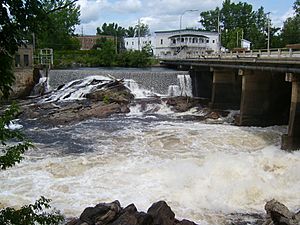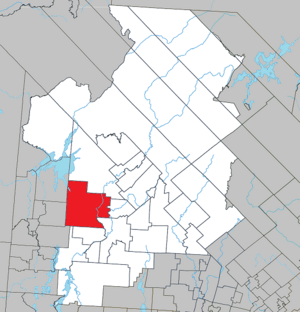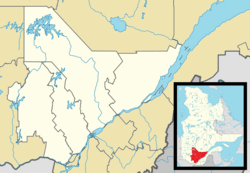Mont-Laurier facts for kids
Quick facts for kids
Mont-Laurier
|
||
|---|---|---|
|
City
|
||

Du Lièvre River in Mont-Laurier
|
||
|
||
| Motto(s):
Laurus elationis praemium
|
||

Location within Antoine-Labelle RCM
|
||
| Country | Canada | |
| Province | Quebec | |
| Region | Laurentides | |
| RCM | Antoine-Labelle | |
| Constituted | January 8, 2003 | |
| Area | ||
| • City | 633.96 km2 (244.77 sq mi) | |
| • Land | 587.42 km2 (226.80 sq mi) | |
| • Urban | 10.40 km2 (4.02 sq mi) | |
| Elevation | 244 m (801 ft) | |
| Population
(2021)
|
||
| • City | 14,180 | |
| • Density | 24.1/km2 (62/sq mi) | |
| • Urban | 7,634 | |
| • Urban density | 733.8/km2 (1,901/sq mi) | |
| • Pop. 2016–2021 | ||
| • Dwellings | 7,223 | |
| Time zone | UTC−5 (EST) | |
| • Summer (DST) | UTC−4 (EDT) | |
| Postal code(s) |
J9L
|
|
| Area code(s) | 819 | |
| Highways | ||
Mont-Laurier is a city in western Quebec, Canada. It sits by the Lièvre River, which flows into the Ottawa River. People call it the "Capital of the Haute-Laurentides." Its motto, Laurus elationis praemium, means "Lift the laurels of reward." People from Mont-Laurier are called Lauriermontois.
In 2021, about 14,180 people lived in Mont-Laurier. It is the main city for the Antoine-Labelle Regional County Municipality. It is also a judicial district, which means it has courts and legal services.
Contents
History of Mont-Laurier
Early Settlers and Naming the Town
The land where Mont-Laurier is now was first home to the Oueskarinis. They were a group of Algonquians, an Indigenous people. European settlers arrived in 1866 from Sainte-Adèle. In 1885, Solime Alix named the place Rapide-de-l'Orignal. This name means "Moose Rapids." A legend says a scared moose made a huge jump over a waterfall on the Lièvre River there.
On October 14, 1909, Mont-Laurier officially became a village. It separated from the Township Municipality of Campbell. The village was named after Sir Wilfrid Laurier, who was Canada's Prime Minister.
Growth with Railways and Roads
Just before Mont-Laurier became a village, a railway line reached it from Montreal. The first train arrived on September 15, 1909. The train station was finished two months later. Mont-Laurier became the end of the railway line. This made it an important place for people to travel and for goods to be moved.
About 100 to 125 freight cars came and went each week. Trains from Montreal brought things like coal and oil. They returned full of wood and animals from the area. In 1940, a new road was built from Mont-Laurier to Abitibi. This helped the trucking industry grow. By the 1960s, more people used the road, and the railway became less important.
Changes in City Status
In 1950, Mont-Laurier officially became a city. Later, in 1971, it joined with the Township Municipality of Brunet. Brunet had taken over from Campbell Township in 1953.
On November 13, 1981, the last passenger train, called the P'tit train du Nord, left Mont-Laurier. Freight trains stopped running in the late 1980s.
In 2003, Mont-Laurier joined with two nearby towns, Des Ruisseaux and Saint-Aimé-du-Lac-des-Îles. They all became one larger municipality called Mont-Laurier. However, in 2004, people in Saint-Aimé-du-Lac-des-Îles voted to separate again. In 2006, Saint-Aimé-du-Lac-des-Îles became its own town once more. Des Ruisseaux stayed part of Mont-Laurier.
Geography and Climate
Location and Natural Features
Mont-Laurier is located on the banks of the Lièvre River. This river is a branch, or "tributary," of the Ottawa River. It is about 200 kilometers (124 miles) from where the Lièvre River joins the Ottawa River.
The city is in the Laurentian Mountains. It sits at an altitude of 244 meters (801 feet) above sea level. Many lakes and mixed forests surround Mont-Laurier. These natural areas are great for hunting, fishing, and other outdoor activities. The forests also support the important logging industry.
Major Roads
Mont-Laurier is roughly halfway between Montreal and Abitibi. It is on Route 117, about 250 kilometers (155 miles) northwest of Montreal. Route 309 follows the Lièvre River. It leads to Gatineau, Quebec and Ottawa, Ontario, which are 216 kilometers (134 miles) to the south.
Local Population Centers
Besides the main city of Mont-Laurier, the municipality also includes other smaller communities. These are Lac-Gatineau, Saint-Jean-sur-le-Lac, and Val-Limoges.
Mont-Laurier's Climate
Mont-Laurier has a humid continental climate. This means it has big differences between its warm summers and very cold winters. It gets a lot of rain and snow all year. This causes a lot of snow to cover the ground in winter.
| Climate data for Mont-Laurier | |||||||||||||
|---|---|---|---|---|---|---|---|---|---|---|---|---|---|
| Month | Jan | Feb | Mar | Apr | May | Jun | Jul | Aug | Sep | Oct | Nov | Dec | Year |
| Record high °C (°F) | 12 (54) |
12 (54) |
19 (66) |
30 (86) |
34 (93) |
34 (93) |
35.5 (95.9) |
36.7 (98.1) |
33.5 (92.3) |
28 (82) |
18.5 (65.3) |
15 (59) |
36.7 (98.1) |
| Mean daily maximum °C (°F) | −7.6 (18.3) |
−4.6 (23.7) |
1.6 (34.9) |
10.3 (50.5) |
18.0 (64.4) |
22.7 (72.9) |
24.8 (76.6) |
23.6 (74.5) |
18.7 (65.7) |
11.0 (51.8) |
3.6 (38.5) |
−4.3 (24.3) |
9.8 (49.6) |
| Daily mean °C (°F) | −13.3 (8.1) |
−10.7 (12.7) |
−4.6 (23.7) |
4.4 (39.9) |
11.4 (52.5) |
16.3 (61.3) |
18.7 (65.7) |
17.4 (63.3) |
12.9 (55.2) |
6.2 (43.2) |
−0.5 (31.1) |
−9.2 (15.4) |
4.1 (39.4) |
| Mean daily minimum °C (°F) | −19.0 (−2.2) |
−16.9 (1.6) |
−10.7 (12.7) |
−1.5 (29.3) |
4.7 (40.5) |
9.9 (49.8) |
12.5 (54.5) |
11.2 (52.2) |
7.0 (44.6) |
1.4 (34.5) |
−4.5 (23.9) |
−14.0 (6.8) |
−1.7 (28.9) |
| Record low °C (°F) | −45.0 (−49.0) |
−40.6 (−41.1) |
−37.0 (−34.6) |
−22.2 (−8.0) |
−11.7 (10.9) |
−3.0 (26.6) |
0.0 (32.0) |
−2.0 (28.4) |
−7.5 (18.5) |
−13.0 (8.6) |
−27.8 (−18.0) |
−42.0 (−43.6) |
−45.0 (−49.0) |
| Average rainfall mm (inches) | 68.6 (2.70) |
54.2 (2.13) |
62.5 (2.46) |
71.2 (2.80) |
90.2 (3.55) |
93.0 (3.66) |
101.1 (3.98) |
99.6 (3.92) |
93.1 (3.67) |
98.4 (3.87) |
88.7 (3.49) |
76.8 (3.02) |
997.2 (39.26) |
Population and Demographics
Population Changes Over Time
The population of Mont-Laurier has changed over the years. In the 2021 Canadian census, 14,180 people lived there. This was a small increase of 0.5% from 2016. The city has a land area of 587.42 square kilometers (226.81 square miles). This means there were about 24.1 people for every square kilometer in 2021.
|
|||||||||||||||||||||||||||||||||||||||
| Canada census – Mont-Laurier community profile | |||
|---|---|---|---|
| 2016 | |||
| Population: | 14,116 (+2.4% from 2011) | ||
| Land area: | 591.27 km2 (228.29 sq mi) | ||
| Population density: | 23.9/km2 (62/sq mi) | ||
| Median age: | 47.7 (M: 46.2, F: 49.5) | ||
| Total private dwellings: | 6,890 | ||
| Median household income: | $47,723 | ||
| References: 2016 earlier | |||
Languages Spoken
Most people in Mont-Laurier speak French as their first language. About 98.5% of the population speaks French. A very small number, about 0.2%, speak English first. Even fewer, 0.1%, speak both English and French as their first languages. About 1.2% of people speak other languages.
Economy of Mont-Laurier
Mont-Laurier is the main center for business and government in the Haute-Lievre area. Many people work for the government, schools, or the hospital.
The city's economy mostly relies on a few key activities:
- Tourism: Many visitors come to enjoy the natural beauty and outdoor activities.
- Road Transport: Moving goods by truck is a big part of the economy.
- Forestry: The logging industry, which involves cutting down trees for wood, is very important.
There is also some farming in the area. Most of this is dairy farming, where cows are raised for milk. This milk is then used to make dairy products.
Notable People from Mont-Laurier
Many interesting people have come from Mont-Laurier:
- Sylvain Pagé – He was a member of Quebec's National Assembly (a type of government leader).
- Yvon Charbonneau – Known as a leader for workers' unions.
- Dan Cloutier – A professional NHL Goaltender (hockey goalie).
- Michel Melançon – The drummer for the band "Emerson Drive".
- Jocelyn Lemieux – A retired NHL player.
- Bobby Bazini – A popular singer-songwriter.
See also
 In Spanish: Mont-Laurier para niños
In Spanish: Mont-Laurier para niños



